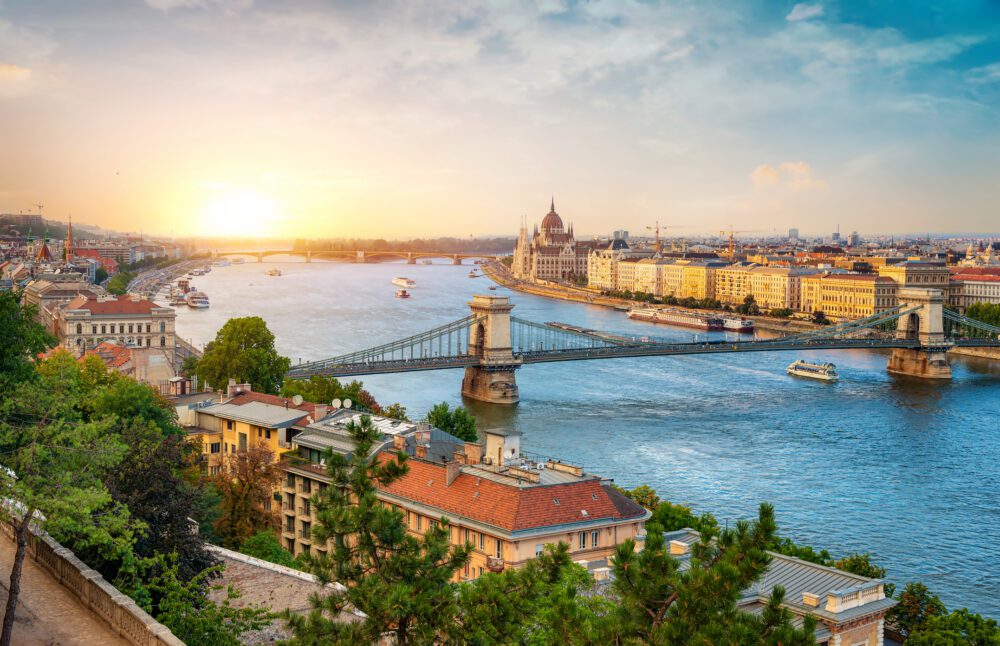
Introduction
Nestled along the banks of the majestic Danube River, Budapest stands as a vibrant testament to its rich history, stunning architecture, and dynamic culture. Often referred to as the “Pearl of the Danube,” this enchanting city is a fusion of old-world charm and modern vitality, offering visitors a captivating blend of medieval monuments, elegant boulevards, thermal baths, and lively nightlife. Budapest’s illustrious past as a hub of the Austro-Hungarian Empire is evident in its grand palaces, majestic cathedrals, and historic bridges, while its contemporary vibe is reflected in its trendy cafes, eclectic art scene, and thriving culinary landscape.
Dating back over a millennium, Budapest boasts a fascinating history that has shaped its identity as one of Europe’s most captivating destinations. From its origins as a Celtic settlement to its time under Roman, Ottoman, and Habsburg rule, Budapest has endured numerous transformations, each leaving its mark on the city’s landscape and culture. The architectural marvels of Buda Castle, Matthias Church, and the Hungarian Parliament Building stand as testaments to Budapest’s illustrious past, while its vibrant Jewish Quarter, bustling markets, and sprawling parks showcase its modern-day allure. With its rich tapestry of history, culture, and attractions, Budapest offers visitors an unforgettable experience that seamlessly weaves together the past and present, making it an exciting and enticing destination for travellers from around the globe.
Table of Contents
Map of the Best Things to Do in Budapest
Hungarian Parliament Building
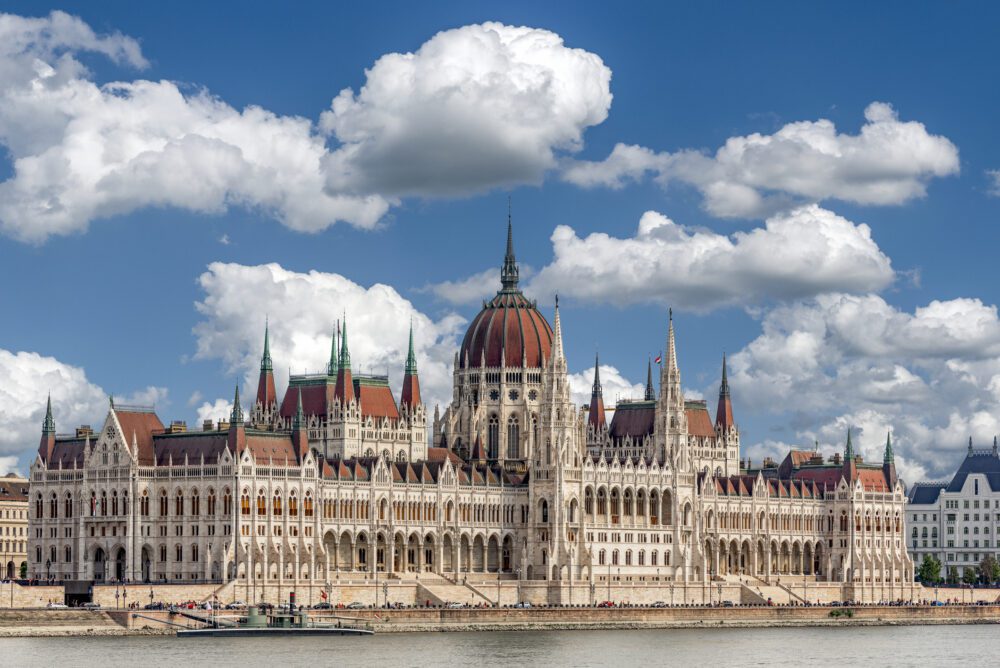
Dominating the banks of the Danube River with its Gothic Revival splendour, the Hungarian Parliament Building is an iconic symbol of Budapest and a must-visit attraction for any traveller. Construction of this majestic edifice began in 1885 as part of the nation’s millennial celebrations, with the aim of showcasing Hungary’s rich history and cultural heritage. Designed by architect Imre Steindl, the Parliament Building is an architectural masterpiece adorned with intricate details, towering spires, and a stunning riverside location that offers breathtaking views from every angle. Visitors can marvel at the building’s exterior adorned with countless statues, including the iconic Turul bird, and explore its opulent interior, which features lavish halls, grand staircases, and the ornate Dome Hall, where the Hungarian Crown Jewels are displayed.
To make the most of your visit to the Hungarian Parliament Building, it’s advisable to book a guided tour in advance to gain insight into its history, architecture, and significance to the Hungarian people. Tours typically include access to the main chambers, such as the Grand Staircase, the Dome Hall, and the Assembly Hall, where the country’s legislative sessions take place. Additionally, visitors can admire the building’s stunning exterior from the adjacent Kossuth Square or enjoy a stroll along the Danube River promenade for panoramic views of this architectural marvel.
Széchenyi Chain Bridge
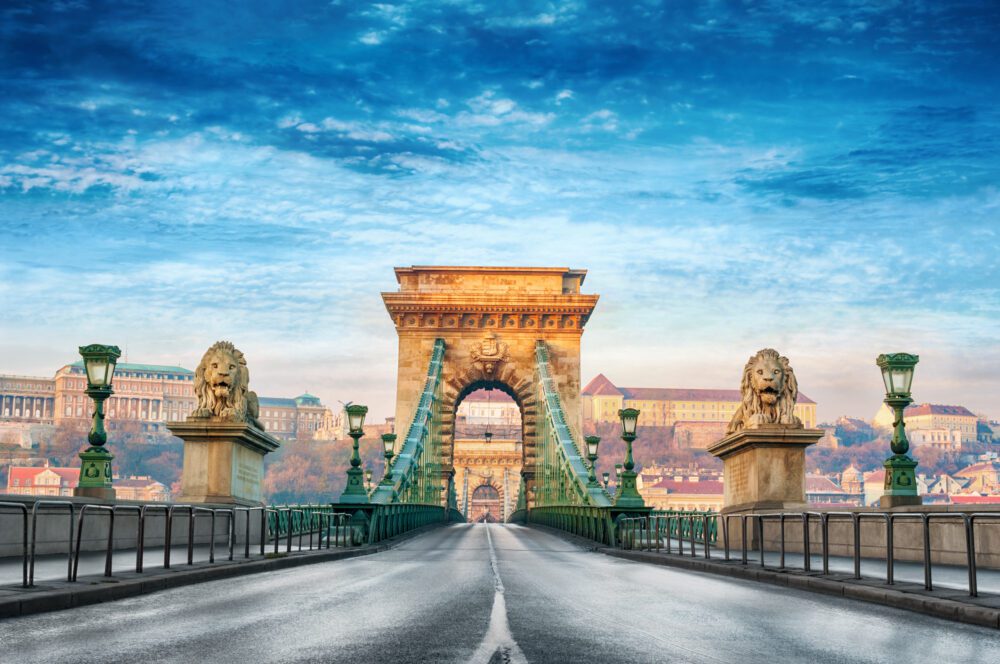
Spanning the majestic Danube River, the Széchenyi Chain Bridge is not only a vital transportation link connecting Buda and Pest but also a symbol of Budapest’s unity and grandeur. Designed by English engineer William Tierney Clark and opened in 1849, the bridge was the first permanent stone bridge to span the Danube in Hungary, marking a significant milestone in the city’s development. Named after Hungarian nobleman István Széchenyi, whose vision for modernizing Hungary included the construction of such a bridge, it stands as a testament to the city’s rich history and architectural prowess. With its iconic lion statues guarding each end and elegant suspension design, the Széchenyi Chain Bridge offers visitors a picturesque backdrop for capturing memorable photos, especially when illuminated against the city’s skyline at night.
For travellers looking to experience the Széchenyi Chain Bridge up close, walking across its pedestrian walkways provides a unique perspective on the city and its landmarks. Whether strolling from Buda to Pest or vice versa, visitors can soak in panoramic views of Budapest’s historic sites, including Buda Castle, the Hungarian Parliament Building, and the Fisherman’s Bastion. Alternatively, taking a leisurely cruise along the Danube River offers a different vantage point, allowing travellers to admire the bridge’s architectural beauty from the water while enjoying a relaxing boat ride.
Buda Castle
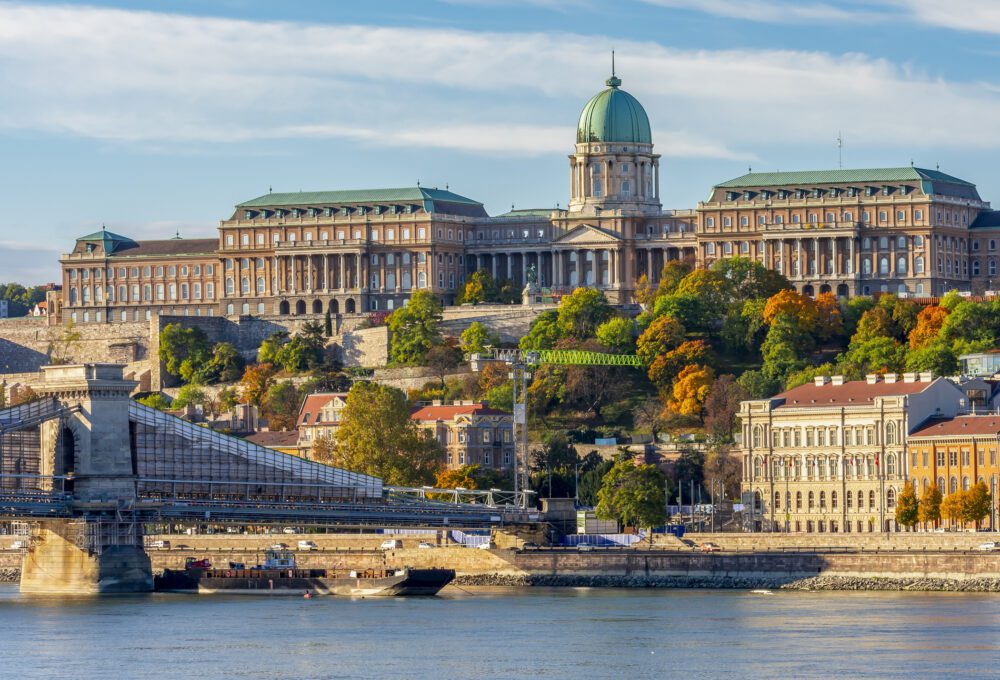
Perched atop Castle Hill on the Buda side of the Danube, Buda Castle is a historic fortress complex that has played a central role in Hungary’s history for centuries. Originally built in the 13th century as a royal residence for Hungarian kings, the castle has undergone numerous renovations and expansions over the years, reflecting various architectural styles from Gothic to Baroque. Today, it stands as a UNESCO World Heritage Site and a symbol of Budapest’s rich cultural heritage. Visitors can explore the castle’s grand courtyards, ornate facades, and historic interiors, including the Hungarian National Gallery and the Budapest History Museum, which offer insights into the city’s past through art and artefacts.
To fully appreciate the beauty and history of Buda Castle, travellers can take a stroll through its picturesque courtyards and gardens, enjoying panoramic views of the city below. The Castle Hill Funicular provides a convenient way to ascend to the castle from the banks of the Danube, offering stunning vistas along the way. Once at the top, visitors can wander through the labyrinthine streets of the Castle District, discovering hidden gems such as Matthias Church and Fisherman’s Bastion. Additionally, guided tours are available for those who wish to delve deeper into the castle’s history and architectural significance.
Fisherman’s Bastion
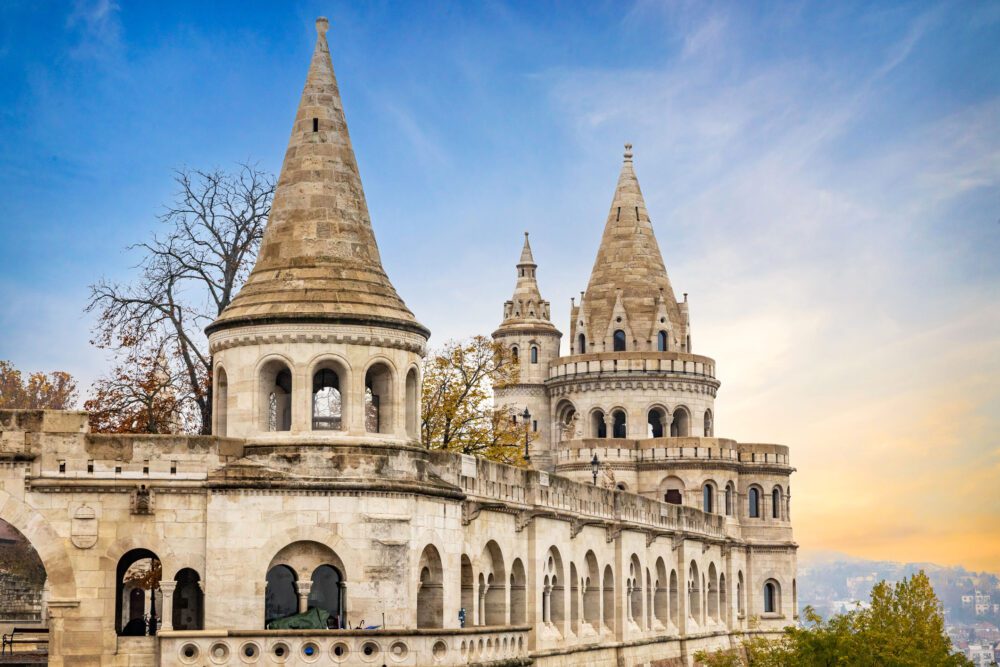
Fisherman’s Bastion, located in the historic Castle District on the Buda side of Budapest, is one of the city’s most iconic landmarks. Built in the late 19th century, this fairy-tale-like structure was designed to serve as a panoramic viewing terrace offering breathtaking views of the Danube River, Pest skyline, and the majestic Hungarian Parliament Building across the water. Despite its name, Fisherman’s Bastion has no military function; instead, it was constructed to commemorate the medieval guild of fishermen who defended this stretch of the city walls during ancient times. The bastion’s seven fairytale-like turrets symbolize the seven Magyar tribes that settled in the Carpathian Basin in the 9th century.
Visitors to Fisherman’s Bastion can ascend its terraces via stairs or elevators to enjoy stunning panoramic views of Budapest. The bastion’s neo-Gothic and neo-Romanesque architecture, adorned with intricate details, creates a romantic and picturesque atmosphere, particularly during sunrise or sunset when the golden light bathes the cityscape in a warm glow. While the upper terraces require a ticket for entry, the lower levels are free to explore, offering ample opportunities for photography and relaxation. It’s also worth noting that Fisherman’s Bastion is illuminated at night, presenting a magical sight against the backdrop of the illuminated city skyline.
Matthias Church

Matthias Church, situated adjacent to Fisherman’s Bastion in Budapest’s Castle District, is a masterpiece of Gothic architecture and one of the city’s most beloved landmarks. Originally built in the 11th century, the church has undergone numerous renovations and reconstructions over the centuries, resulting in its current stunning appearance. Its colourful tiled roof, intricately carved stone façade, and soaring spires make it a prominent feature of Budapest’s skyline. The church is named after King Matthias Corvinus, who famously held his wedding ceremony here in the 15th century. Stepping inside, visitors are greeted by a richly decorated interior adorned with elaborate frescoes, stained glass windows, and ornate sculptures. Highlights include the breathtaking altar, the intricately carved pulpit, and the stunning rose window.
Visitors to Matthias Church can explore its interior and marvel at its architectural and artistic treasures. Guided tours are available for those who wish to learn more about the church’s history and significance. Additionally, attending a concert or organ recital within the church provides a unique opportunity to experience its acoustics and ambience in a different light. After exploring the church, visitors can also take some time to stroll around the surrounding Castle District, soaking in the charming cobblestone streets, historic buildings, and panoramic views of the Danube River and Pest side. For the best experience, consider visiting early in the morning or later in the afternoon to avoid the crowds and enjoy a quieter atmosphere.
Margaret Island

Margaret Island, nestled in the heart of the Danube River, offers a serene escape from the hustle and bustle of Budapest. Named after Princess Margaret of Hungary, who lived there in the 13th century, the island is a peaceful oasis filled with lush greenery, flower gardens, and scenic walking paths. Visitors can reach the island by walking across the Margaret Bridge or taking a leisurely boat ride along the Danube. Once on the island, there are plenty of attractions to explore, including the medieval ruins of a Dominican convent, the iconic Water Tower, and the picturesque Japanese Garden. For those seeking relaxation, the island boasts several thermal springs, making it an ideal spot for a rejuvenating soak in one of the outdoor thermal baths.
In addition to its natural beauty, Margaret Island offers a variety of recreational activities for visitors of all ages. Cyclists can rent bikes and explore the island’s numerous bike paths, while joggers can take advantage of the scenic running trails that wind through the park. The island also features sports facilities such as tennis courts, a swimming pool, and mini-golf courses, providing ample opportunities for outdoor fun and exercise. Families with children will appreciate the playgrounds and picnic areas scattered throughout the island, making it a perfect destination for a day of family-friendly entertainment.
Danube River Cruise
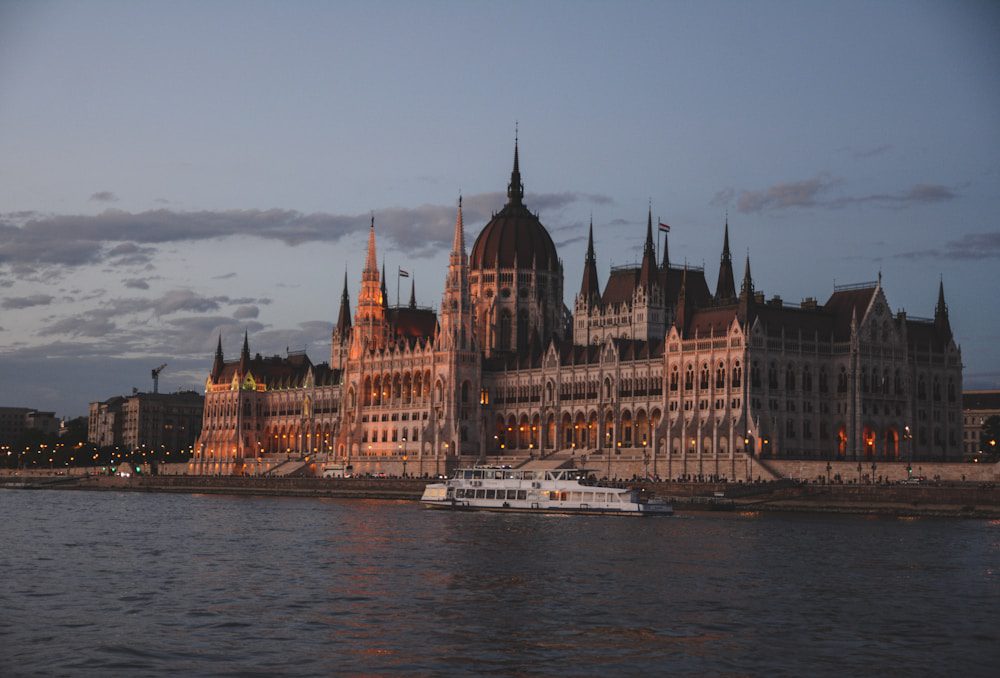
A Danube River cruise is an unforgettable way to experience the beauty and grandeur of Budapest from a unique vantage point. As Europe’s second-longest river, the Danube has played a significant role in the history and culture of the region for centuries. Cruising along its majestic waters, travellers can marvel at iconic landmarks such as the Hungarian Parliament Building, Buda Castle, and the Chain Bridge, all illuminated in the evening, creating a magical ambience. Many cruises also pass by Margaret Island, providing passengers with breathtaking views of its lush greenery and historic landmarks. Additionally, a Danube River cruise offers the opportunity to learn about Budapest’s rich history and cultural heritage through informative commentary provided by knowledgeable guides on board.
Practical tips for enjoying a Danube River cruise include choosing the right time of day for the best experience. Evening cruises, especially those scheduled around sunset, offer stunning views of Budapest’s illuminated skyline and landmarks. Additionally, consider booking a dinner cruise to indulge in delicious Hungarian cuisine while taking in the sights along the river. It’s also advisable to book tickets in advance, especially during peak tourist seasons, to secure your preferred time slot and ensure availability. Finally, don’t forget to bring a camera to capture the breathtaking scenery and unforgettable moments as you glide along the Danube, immersing yourself in the beauty and romance of Budapest from the water.
Heroes’ Square
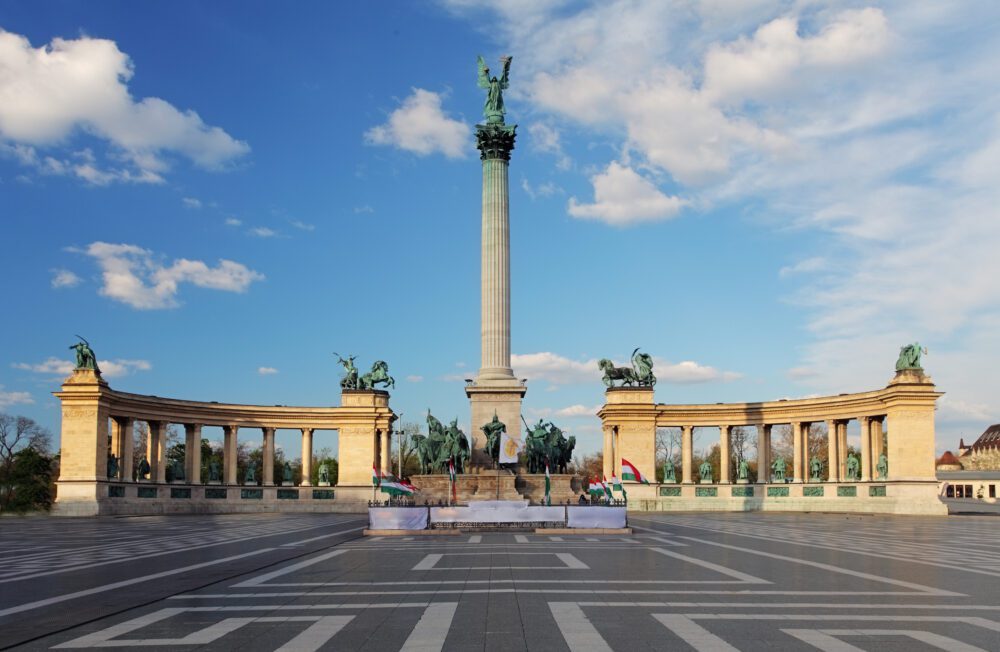
Heroes Square is one of Budapest’s most iconic landmarks and a must-visit attraction for travellers exploring the city’s rich history and culture. Situated at the end of Andrássy Avenue, this grand square is dominated by the Millennium Monument, a majestic column topped with the Archangel Gabriel and surrounded by statues of prominent Hungarian leaders, kings, and historical figures. The square was originally built in 1896 to commemorate the 1,000th anniversary of the arrival of the Magyars in the Carpathian Basin and has since become a symbol of national pride and identity for Hungarians. Visitors to Heroes Square can admire the impressive architecture and sculptures, which represent Hungary’s storied past and celebrate its cultural heritage.
Practical tips for exploring Heroes Square include taking the time to visit the nearby museums and attractions that flank the square. The Museum of Fine Arts and the Palace of Art are located on either side of the square and offer excellent opportunities to delve deeper into Hungarian art and culture. Additionally, consider visiting Heroes Square during off-peak hours to avoid crowds and fully appreciate its grandeur and significance. For those interested in learning more about the history and symbolism of the monuments in the square, guided tours are available, providing fascinating insights into Hungary’s past and its national identity.
Széchenyi Thermal Baths

Szechenyi Thermal Baths, located in the City Park of Budapest, are among the largest and most famous thermal baths in Europe, attracting visitors from around the world seeking relaxation and rejuvenation. The baths are housed in a stunning Neo-Baroque building and feature a variety of indoor and outdoor pools filled with natural thermal waters sourced from deep underground springs. With temperatures ranging from 18 to 38 degrees Celsius, these mineral-rich waters are believed to have therapeutic properties, offering relief for various ailments such as arthritis and muscle pain. The history of the baths dates back to the late 19th century when they were first opened to the public, and they have since become an integral part of Budapest’s spa culture and heritage.
Practical tips for visiting Szechenyi Thermal Baths include arriving early in the day to avoid crowds, especially during peak tourist seasons. Visitors can choose from a range of ticket options, including single entry or packages that include access to additional facilities such as saunas and massage treatments. It’s recommended to bring your own towel, flip-flops, and swimwear, although rentals are available onsite. For a truly relaxing experience, consider indulging in a traditional Hungarian thermal massage, which can help alleviate tension and stress. After soaking in the soothing thermal waters, take time to explore the beautiful architecture of the baths and relax in the tranquil outdoor pools surrounded by ornate columns and statues.
St. Stephen’s Basilica

St. Stephen’s Basilica, one of Budapest’s most iconic landmarks, stands as a testament to the city’s rich architectural heritage and religious significance. Named after Hungary’s first king, St. Stephen, the basilica is a stunning example of neoclassical design, boasting a grand dome that dominates the city skyline. Construction of the basilica began in the 19th century but was interrupted several times due to various challenges, including the collapse of the dome during construction. Despite these setbacks, the basilica was finally completed in 1905 and has since become a symbol of national pride. Visitors to St. Stephen’s Basilica can admire its magnificent exterior adorned with intricate sculptures and reliefs, as well as its equally impressive interior featuring ornate decorations, marble altars, and stunning stained glass windows.
Practical tips for visiting St. Stephen’s Basilica include arriving early in the day to avoid crowds and taking advantage of the opportunity to climb to the top of the dome for panoramic views of Budapest. While admission to the basilica is free, donations are encouraged to support its maintenance and preservation efforts. Inside the basilica, visitors can also marvel at the mummified right hand of St. Stephen, housed in a reliquary chapel and considered a sacred relic by believers. Additionally, attending a classical music concert or organ recital held in the basilica is a unique way to experience its awe-inspiring acoustics and immerse yourself in its spiritual ambience.
The Great Synagogue
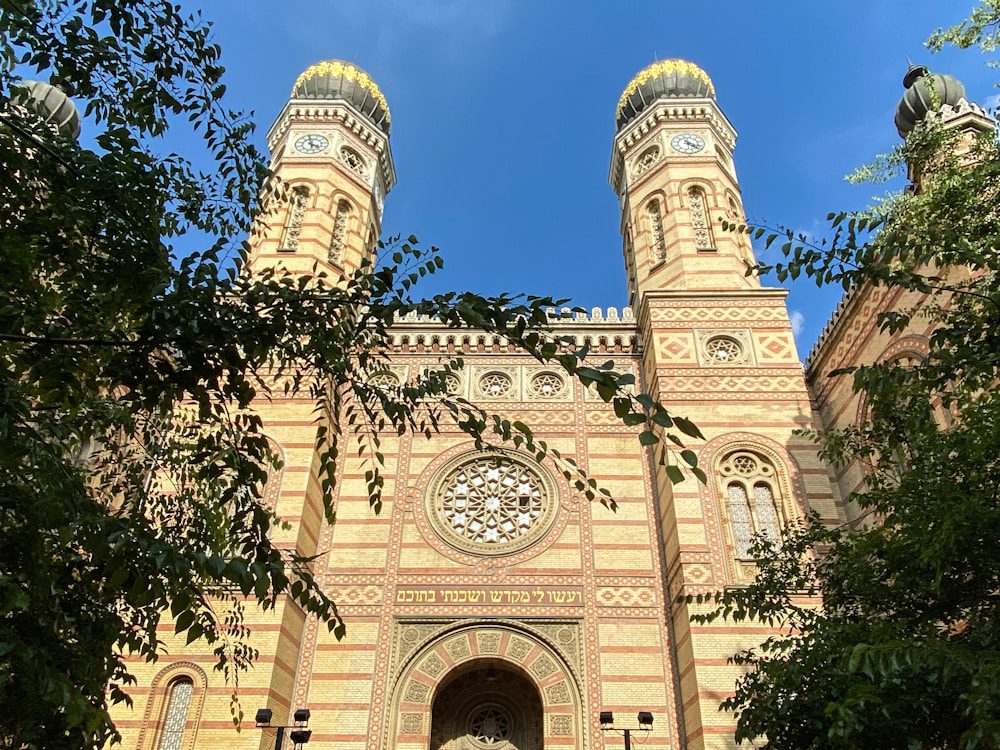
The Great Synagogue, also known as the Dohány Street Synagogue, stands as a significant symbol of Budapest’s Jewish heritage and resilience. Constructed in the mid-19th century in Moorish Revival style, it is the largest synagogue in Europe and one of the largest in the world. The synagogue has witnessed both moments of triumph and tragedy throughout its history, including its use as a shelter for Jewish citizens during World War II. Today, it serves as a place of worship, remembrance, and cultural celebration. Visitors to the Great Synagogue can explore its magnificent architecture, including its stunning interior adorned with intricate decorations, colourful stained glass windows, and a breathtaking ark containing the Torah scrolls. The adjacent Jewish Museum and Holocaust Memorial provide further insights into the rich history and enduring spirit of Budapest’s Jewish community.
Practical tips for visiting the Great Synagogue include purchasing tickets in advance to avoid long lines, especially during peak tourist seasons. Guided tours are available and highly recommended to gain a deeper understanding of the synagogue’s significance and the history of Hungarian Jewry. Visitors should also dress modestly and respectfully when entering the synagogue out of respect for its religious significance. Additionally, taking the time to explore the surrounding Jewish Quarter, with its vibrant streets, kosher eateries, and eclectic shops, offers a more comprehensive experience of Budapest’s Jewish heritage.
Central Market Hall
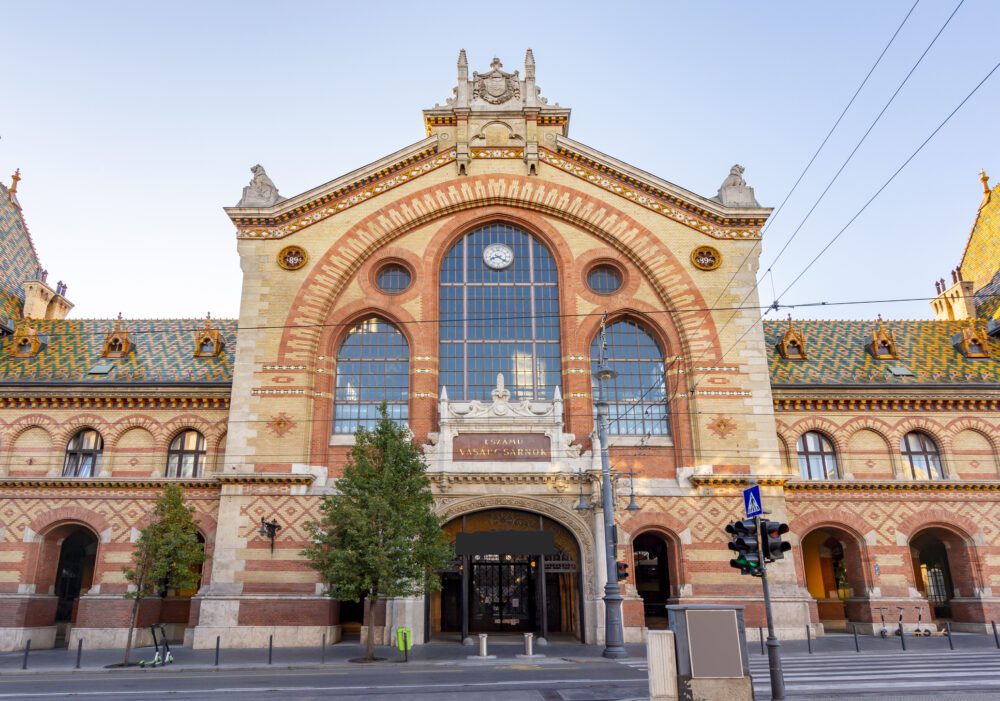
The Central Market Hall, or Nagyvásárcsarnok, is one of Budapest’s most iconic landmarks and a vibrant hub of culinary delights. Opened in 1897, this majestic building is a testament to the city’s rich architectural heritage, featuring a distinctive Neo-Gothic design with colourful Zsolnay tiles and a soaring wrought-iron roof. Originally conceived as a marketplace where locals could purchase fresh produce, meats, and other essentials, the Central Market Hall remains true to its roots while also catering to modern tastes and trends. Visitors can explore its bustling aisles filled with stalls selling a wide array of goods, from traditional Hungarian delicacies like paprika and lángos to artisanal cheeses, meats, and pastries. The market’s upper level is home to a variety of vendors offering handcrafted souvenirs, textiles, and traditional Hungarian crafts, making it an ideal spot to pick up unique gifts and mementoes.
Practical tips for visiting the Central Market Hall include arriving early in the day to avoid crowds and ensure the best selection of fresh produce and goods. It’s also wise to bring cash, as many vendors may not accept credit cards. Food enthusiasts should not miss the opportunity to sample local specialities like lángos (deep-fried bread), goulash, and chimney cake from the market’s numerous food stalls and eateries. Additionally, taking a stroll along the nearby Danube River promenade after exploring the market offers stunning views of Budapest’s iconic landmarks, including the Chain Bridge and Buda Castle.
Gellért Hill
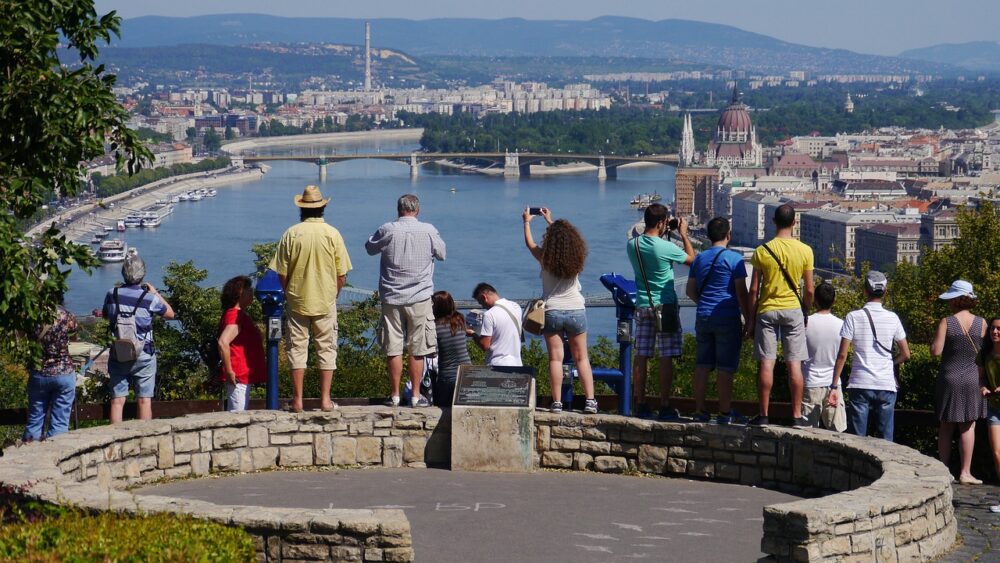
Gellért Hill, named after Saint Gellért, a Hungarian bishop who was allegedly martyred on the hill in the 11th century, offers visitors breathtaking panoramic views of Budapest and the Danube River. Steeped in history and legend, the hill is home to several iconic landmarks, including the imposing Citadella fortress, which was built by the Habsburgs in the 19th century to quell Hungarian uprisings. Today, the Citadella serves as a popular tourist destination, providing visitors with sweeping vistas of the cityscape below. At the foot of Gellért Hill lies the historic Gellért Thermal Bath, one of Budapest’s most famous thermal spas, renowned for its healing waters and stunning Art Nouveau architecture. Visitors can unwind in the bath’s thermal pools, saunas, and steam rooms while marvelling at the intricate mosaic tiles and stained glass windows that adorn the interior.
Practical tips for exploring Gellért Hill include wearing comfortable shoes, as the climb to the top can be steep and challenging for some. Those who prefer a less strenuous ascent can opt to take the Liberty Bridge or bus to the halfway point and then walk the rest of the way. Sunset is an ideal time to visit Gellért Hill, as it offers spectacular views of the city illuminated by the golden hues of the setting sun. Additionally, history enthusiasts may enjoy exploring the remnants of the Liberation Monument, a towering statue erected by the Soviets in 1947 to commemorate their liberation of Budapest from Nazi occupation during World War II.
Budapest Ruin Bars

Ruin bars are a unique and vibrant aspect of Budapest’s nightlife scene, known for their eclectic atmosphere and quirky décor. These establishments are typically housed in dilapidated buildings or abandoned spaces, which have been repurposed into trendy bars, cafes, and art galleries. The concept of ruin bars emerged in the early 2000s when enterprising entrepreneurs began transforming abandoned buildings in the city’s historic Jewish Quarter into hip hangout spots. Szimpla Kert, one of the first ruin bars to gain popularity, opened its doors in 2004 and quickly became a cultural icon. Today, ruin bars can be found throughout Budapest, each offering its own distinct vibe and ambience.
Visitors to Budapest can explore the city’s ruin bars to experience its thriving underground culture and vibrant nightlife. Szimpla Kert remains a must-visit destination, with its sprawling complex featuring multiple bars, lounges, and outdoor spaces adorned with an eclectic array of vintage furniture, graffiti, and art installations. Other popular ruin bars include Instant, Fogas Ház, and Mazel Tov, each offering a unique atmosphere and entertainment options ranging from live music performances to film screenings and art exhibitions. Practical tips for enjoying Budapest’s ruin bars include arriving early to avoid long lines, especially on weekends when they tend to be crowded. Additionally, be sure to bring cash, as some ruin bars may not accept credit cards. Exploring these unconventional and creative spaces is an essential part of experiencing Budapest’s dynamic nightlife and cultural scene.
Szentendre Day Trip
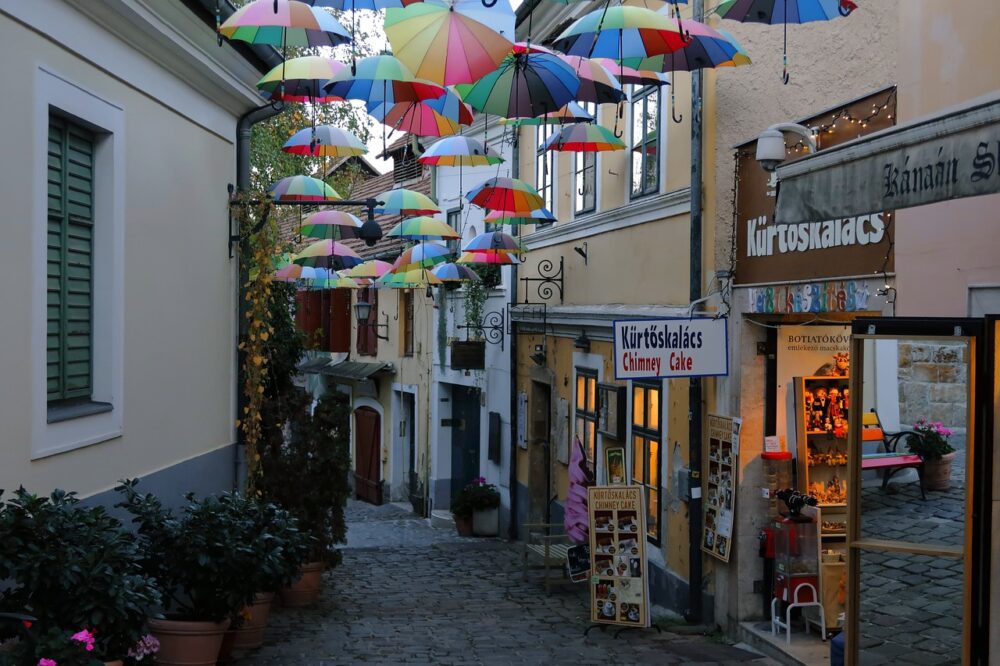
A day trip to Szentendre offers visitors a delightful escape from the bustling streets of Budapest to a picturesque town brimming with history and charm. Located just a short distance from the Hungarian capital, Szentendre is situated on the banks of the Danube River and is renowned for its well-preserved Baroque architecture, colourful houses, and artistic heritage. The town’s history dates back to Roman times when it was known as Ulcisia Castra, later becoming a significant settlement under Serbian rule in the Middle Ages. Today, Szentendre is celebrated for its thriving arts community, attracting painters, sculptors, and craftsmen from around the country.
Upon arriving in Szentendre, visitors are greeted by its quaint cobblestone streets, lined with charming shops, galleries, and cafes. The town’s main square, Fő tér, is a bustling hub of activity, surrounded by historic buildings and adorned with sculptures and fountains. One of the highlights of Szentendre is the Hungarian Open Air Museum, an expansive outdoor museum showcasing traditional Hungarian architecture and rural life. Visitors can wander through authentic village houses, churches, and workshops, gaining insight into Hungary’s cultural heritage. Art enthusiasts will appreciate the numerous galleries and studios scattered throughout the town, where they can admire and purchase works by local artists. Practical tips for a day trip to Szentendre include taking the HEV commuter train from Budapest’s Batthyány tér station, which provides a scenic journey along the Danube River to the town.
Conclusion
Budapest offers a rich tapestry of history, culture, and experiences that captivate visitors from around the world. From its grandiose architecture and thermal baths to its vibrant nightlife and culinary scene, the Hungarian capital leaves an indelible impression on all who visit. Whether wandering the streets of the historic Buda Castle District, cruising along the Danube River at sunset, or immersing oneself in the lively atmosphere of the ruin bars, Budapest promises unforgettable moments and cherished memories.
As you plan your visit to Budapest, consider exploring its diverse neighbourhoods and landmarks, each offering a unique glimpse into the city’s past and present. Whether you’re drawn to its iconic landmarks, hidden gems, or culinary delights, Budapest’s allure is boundless, promising a memorable experience that will linger long after you’ve departed. So pack your bags, prepare to be enchanted by the magic of Budapest, and embark on a journey of discovery in one of Europe’s most captivating cities.
